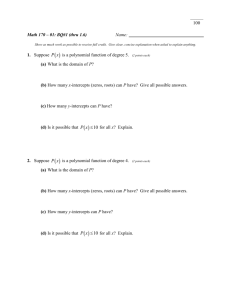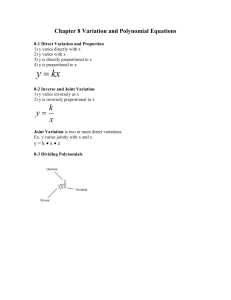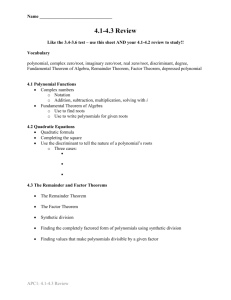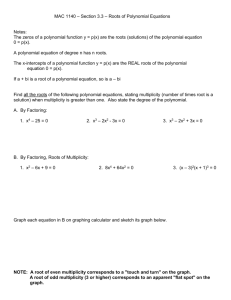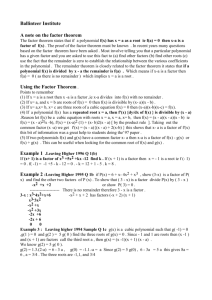theorem polynomial
advertisement
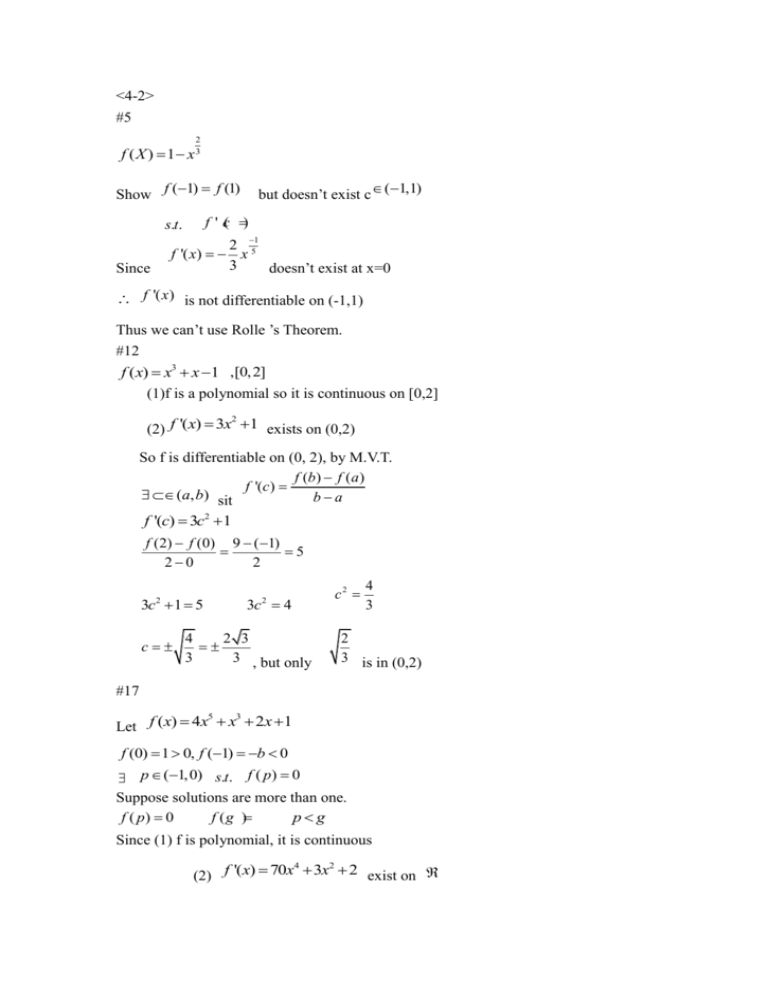
<4-2> #5 2 f ( X ) 1 x 3 Show f (1) f (1) but doesn’t exist c ( 1,1) f ' c( ) s.t. 2 f '( x) x 3 Since 0 1 5 doesn’t exist at x=0 f '( x) is not differentiable on (-1,1) Thus we can’t use Rolle ’s Theorem. #12 f ( x) x3 x 1 ,[0, 2] (1)f is a polynomial so it is continuous on [0,2] 2 (2) f '( x) 3x 1 exists on (0,2) So f is differentiable on (0, 2), by M.V.T. f (b) f (a ) f '(c) (a, b) sit ba f '(c) 3c2 1 f (2) f (0) 9 ( 1) 5 20 2 3c 1 5 2 c 3c 4 2 4 2 3 3 3 , but only c2 4 3 2 3 is in (0,2) #17 5 3 Let f ( x) 4x x 2x 1 f (0) 1 0, f (1) b 0 p (1,0) s.t. f ( p) 0 Suppose solutions are more than one. f ( p) 0 f ( g ) 0 p g Since (1) f is polynomial, it is continuous 4 2 (2) f '(x) 70x 3x 2 exist on By Rolle’s Theorem. There is a number ( p, g ) 4 2 s.t. f '(c) 0 f '(x) 20x 3x 2 0 ∴ f has exactly one real root. #21 (a) suppose that a cubic polynomial p(x) has roots a1 a2 a3 a4 , so P(a1) P(a2 ) P(a3 ) P(a4 ) . By Rolle’s Theorem there are numbers a1, a2 , a3 with a1 c1 a2 , a2 c2 a3 , a3 c3 a4 , and P '(c1 ) P '(c2 ) P '(c3 ) 0 . Thus the second-degree polynomial P '( x) has three distinct real roots, which is impossible. (b) We prove by induction that a polynomial of degree n has at most n real roots. This is certainly true for n=1. Suppose that the result is true for all polynomials of degree n. And let P ( x ) be a polynomial of degree n+1, suppose that P ( x ) has more than n+1 real roots, say a1 a2 a3... an1 an2 , then P(a1 ) P(a2 ) ... P(an2 ) 0 . By Rolle’s Theorem, there are real numbers c1...cn1 with a1 c1 c2 , a2 c2 a3...an1 cn1 cn2 , and P '(a) P '(c2 ) ...P '(cn1) 0 . Thus the nth degree polynomial P '( x) has at least n+1 roots. This contradiction shows that P ( x ) has at most n+1 real roots. #23 By the Mean Value Theorem, f (4) f (1) f '(c)(4 1) for some c (1, 4) . But for every c (1, 4) we have f '(1) 2 . Putting f '(1) 2 into the above question and substituting f (1) 10 , we get f (4) f (1) f '(c)(4 1) 10 3 f '(c) 10 3 2 16 . So the smallest possible value of f (4) is 16. #25 f is a fuction which f '( x) 2 and f (0) 1 , f (2) 4 . f '( x) exists on ( ,2) f is continuous on . f '(1) By M.V.T. (0, 2) s.t. 5 f '(c) 2.5 2 f '( x) 2 2 f (2) f (0) 20 ∴ There doesn’t exist such a fuction. #31 f ( x) 1 x g ( x) 1 x 1 if x>0 1 x if x<0 For x>0 f ( x) g ( x) f '( x) g '( x) For x<0 f '( x) ( x 1 ) ' x 2 g '( x) (1 x1 ) ' x 2 f '( x) g '( x) No. since f '( x) g '( x) ∴ f ( x) g( x) c1 x ( ,0 ) ( 0 , ) on (, 0) and f (x) g(x) c2 on (0, ) Not. f ( x) g ( x) c on Since f '( x) g '( x) at x=0 #35 Let f (t ) g (t ) h(t ) g , h are the position functions of two runners. Suppose they spent T secs on the race. Since g and h are differentiable on (0,T) and continuous on [0,T] f (T ) f (0) 0 0 f '(c) 0 T 0 T By M.V.T. (0, T ) s.t. f ' (c ) g ' c ( ) h 'c ( ) 0 g ' (c ) h ' c( ) Hence they have same speed at t c .
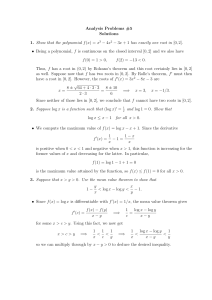


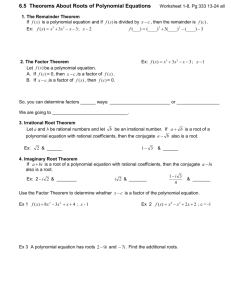
![is a polynomial of degree n > 0 in C[x].](http://s3.studylib.net/store/data/005885464_1-afb5a233d683974016ad4b633f0cabfc-300x300.png)
